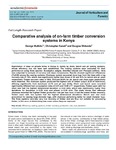| dc.description.abstract | Exploitation of trees on private farms in Kenya is mainly by chain, bench and pit sawing systems,
whose efficiency has not been well established. The sawing systems were evaluated for their
performance using three species: Eucalyptus saligna, Grevillea robusta and Prosopis juliflora. Data
was subjected to analysis of variance and mean comparisons. Results showed significant differences
(P<0.05) among the sawing systems. Chainsaw system recovered more logs from the trees with a log
recovery rate of 76%, which was significantly higher than those of 65 and 63% for bench and pit saws
respectively. Timber recovery rates of 39.8, 35.9 and 30.0% for pit, bench and chain saws respectively
were observed. The chainsaw system produced the highest rate of timber output (0.23 m
3
/man-hour),
differing significantly from benchsaw (0.17) and pit saw (0.08). Chain and bench saws recorded
significantly different fuel consumption rates of 8.41 and 14.86 m3
l
-1 respectively. Timber sawn with the
chain saw had the highest dimensional deviation (+/-5.53 mm), which was significantly higher than
deviations for benchsaw (+/-3.55 mm) and pitsaw (+/-2.44 mm). The study shows that, although
chainsaw recorded the highest timber production rate per man hour, it had the lowest timber recovery.
Timber sawn with this system had the highest dimensional deviations. Bench saw was more
economical for sawing large diameter logs, with chainsaw performing better for small diameter logs.
The three systems recorded very low recovery of timber and are thus not suitable for processing
timber, in this error of diminishing tree cover unless they are improved. | en_US |

